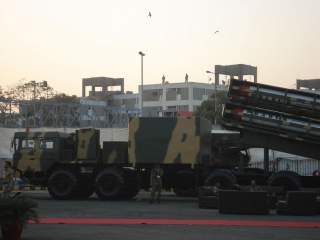Pakistan’s New Missile Disrupts Nuclear Stability in South Asia
The Shaheen III is dangerous to the nuclear balance in South Asia.
Pakistan recently test-fired a surface-to-surface ballistic missile, Shaheen III. Capable of carrying a nuclear warhead, the missile is estimated to have a maximum range of 2750 km. While it has been claimed to provide a boost to Pakistan’s strategic depth and to deterrence stability in South Asia, a careful examination of how Shaheen III impacts the deterrence equation between India and Pakistan captures the latest Pakistani missile to be instead counter-productive.
Shaheen III is the latest addition in the Shaheen series. The previously developed and successfully tested missile, Shaheen II, is estimated to have a range of around 2500 km. The range of Shaheen II continues to remain a rough estimate. For instance, right after Pakistan tested Shaheen II in March 2004, Pakistan’s National Engineering and Science Commission (NESCOM) chairman, Samar Mubarakmand, was quoted saying that “the full range of the missile was 2,500 km although it was tested only to 2,000 km, the edge of Pakistan’s sea limits.” Another ISPR press statement issued on April 18, 2008, after the second successful test of the Shaheen II missile, however, confirmed the missile to have a range of 2000 km. But leading Pakistani newspapers claim Shaheen II to have a range of 1500 km. Based on an estimated range of 2000 km, a map has been made by C SIS that depicts the area (marked with blue dotted lines) that Pakistan could target using Shaheen II ballistic missile. This is critical to note as we question what new capabilities Shaheen III brings to the table.
Right after the launch of Shaheen III, Shahid Latif, retired commander of Pakistan’s air force was quoted as saying that “India doesn’t have its safe havens anymore.” With the ability to reach India’s extreme eastern frontiers, Director General of the Strategic Plans Division, Lieutenant General Zubair Mahmood Hayat, called Shaheen III “a major step towards strengthening Pakistan’s deterrence capability” vis-à-vis India. However, despite all the claims made by strategic experts and military leaders in Pakistan, there remains question on whether Shaheen III enhances the deterrence stability or is rather counter-productive.
From India’s perspective, Shaheen III does not really change the situation much as far as the credibility of Pakistan’s deterrent is concerned. Looking purely from a strategic point of view, Pakistan has had the ability to target all of India’s major population centers with Shaheen II, whose maximum range (2500 km) is estimated to be shorter than that of Shaheen III by only 250 km. Even if we go by the estimated range of Shaheen II at 2000 km which has been successfully tested by Pakistan and confirmed by ISPR, the missile would only miss the extreme eastern tips of India. Thus, when it comes down to “deterrence capability,” Shaheen II can deliver a nuclear warhead to almost all of the strategic sites of India to make the preexisting deterrent credible.
Shaheen III could offer Pakistan the ability to target Indian naval vessels in the Bay of Bengal, but for that Pakistan would need a highly effective and accurate terminal guidance system which could help a missile trace the targeted vessel’s movement and adjust its trajectory accordingly after flying across the entire Indian mainland. Another asset which would make Shaheen III stand out could be the multiple independently targetable re-entry vehicle (MIRV) capabilities, but Pakistan could use these payloads on Shaheen II as well, if it is able to develop or acquire them.
The purpose that Shaheen III could serve best, however, is to give Pakistan the ability to target Andaman and Nicobar islands in the Bay of Bengal. This, as has been argued by General Khalid Kidwai, former head of the Strategic Plans Division (SPD) and advisor to Pakistan’s National Command Authority in a conversation at the 2015 Carnegie International Nuclear Policy Conference, is the “sole purpose for the development of Shaheen III.” However, in the same conversation, he also added that by covering the islands of Andaman and Nicobar, Pakistan aims to take away India’s second-strike capability. But that goes far off from making Shaheen III a strategic deterrent, which Pakistan claims it to be. Instead of strengthening the concept of mutually-assured destruction (MAD), which Gen. Kidwai argues to be critical for South Asia, attempts to take away India’s second-strike capability will further destabilize the deterrence equation. It will push India to further cooperate with its global partners on its Ballistic Missile Defence Programme which will definitely be counter-productive for Pakistan.
Thus, while much has been stated and claimed about Shaheen III from the Indian perspective, it really does not bring anything new to the tableas far as deterrence stability is concerned. On the other hand, if Pakistan aims to take-away India’s second-strike capability, as Gen. Kidwai argues the purpose to be, it will only push India to further enhance its BMD systems. Indian doctrine of credible minimum deterrence is solely based on having a nuclear force that is capable of surviving a nuclear first-strike and launching a second strike which can inflict massive damage to the opponent to make the deterrent credible. Retention of second-strike capability is therefore a vital for stability in South Asia and development of Shaheen III by Pakistan with the aim of taking away India’s second-strike capability will only prove to be counter-productive for the former.
Arka Biswas is a SAV Visiting Fellow at the Stimson Center. This article originally appeared on South Asian Voices, here.

